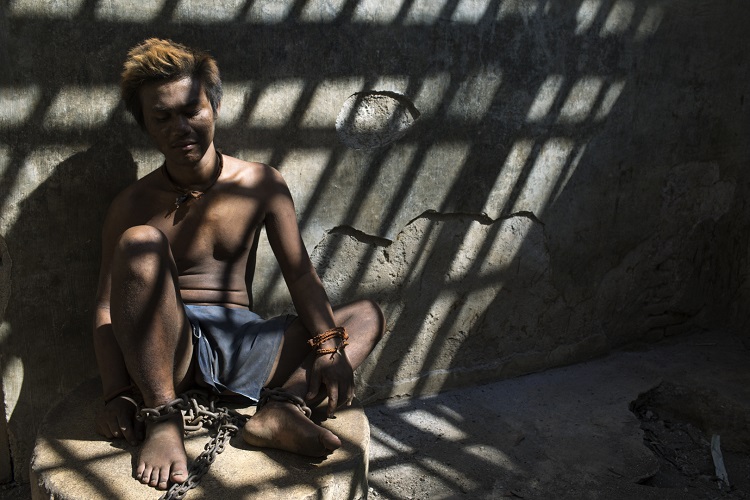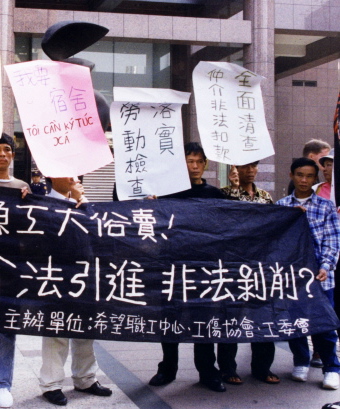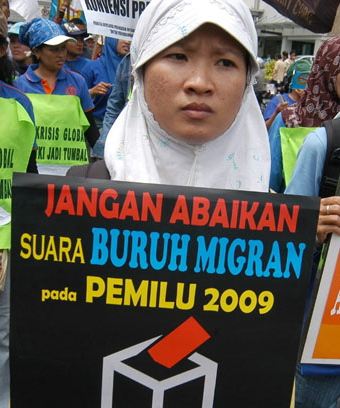A photojournalist reflects on a decade of documenting the fate of individuals with psychosocial disabilities in Indonesia
Versi Bh. Indonesia
A photojournalist reflects on a decade of documenting the fate of individuals with psychosocial disabilities in Indonesia
Andrea Star Reese
While visiting Indonesia in November 2010, I saw a man dressed in rags walking along a road in rural Java. I asked my Indonesian fixer, a local guide/co-investigator/translator who partners with me on my work: ‘What happens to people who are mentally ill?’ Gunawan answered: ‘I don’t know, but I think it is bad’. ‘That’s our next story,’ I replied. I decided at that moment to document the often-dreadful fate of individuals with mental illness in Indonesia.
I have been reporting on people with a real or perceived psychosocial disability in Indonesia and documenting their lives. I have visited and revisited over one hundred places where they live, including panti sosial (government-run social care institutions), panti (licensed and unlicensed social care institutions), informal facilities such as pesantren (faith-based boarding schools), mental rehabilitation centres, hospitals and private homes.
In 2018, I visited East Java. One day I met a 40-year-old former teacher, Siti Z., who was incarcerated in a small room at her family home. Her sister described her behaviour as ‘angry, destructive and antisocial’. Her mother, Supilah, said that Siti had been bewitched by a man who loved her. Siti disagreed. Siti had stopped teaching religion at the local Islamic boarding school, preferring to stay at home. Ultimately, her family thought that they had no choice but to confine her.
I asked Supilah to unlock the door. She did, and I saw a closet-sized cell containing only a tiny bed. Siti’s mother explained that the family had never taken Siti to a hospital because they did not have the money to pay for medical care. Recently, however, the outreach team of the local community health centre had come to visit. They offered mental health treatment and provided medication.
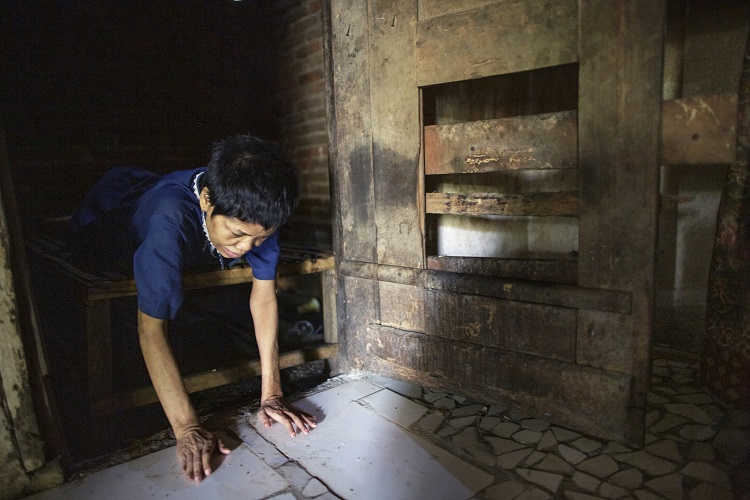
Now that the door to her small cell was open, Siti inched forward and looked around. She reached down to touch the floor with one finger and then with both hands. She pulled her body forward. For the first time in 12 years, Siti emerged from her room. Unexpected. Spontaneous. An act of self-liberation. Words are inadequate to describe the significance of Siti’s decision.
Unfortunately, she was not able to stand up, so she climbed onto a chair, fascinated by some family photographs hanging on the wall. She crawled to the front door and peered outside, into the light and into the sky and decided to sit on a nearby chair. She smiled.
I photographed the family for several hours that day, an observant fly on the wall.
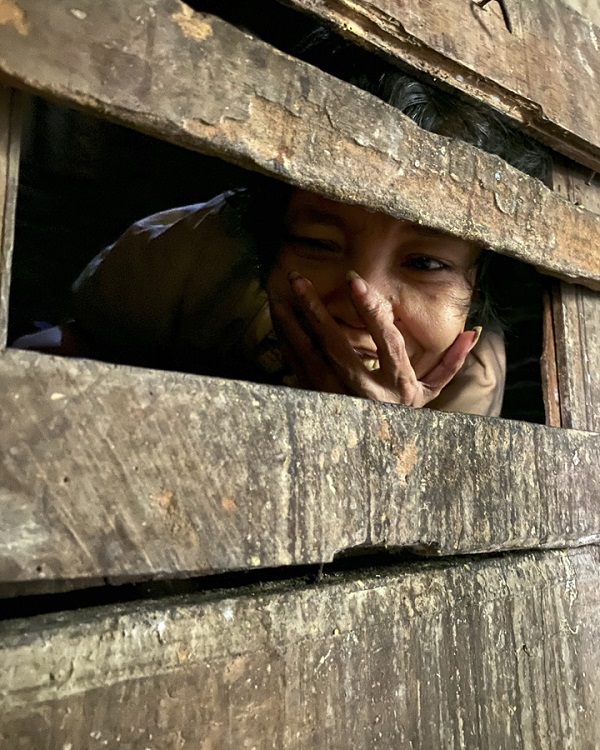
In late 2019, I returned. I learned that Siti’s sister had died, and her mother, overwhelmed with grief and exhaustion, told me she was unable to supervise Siti adequately without another family member to help. She was afraid to allow the visiting clinic team to take Siti to a mental hospital for treatment because ‘they die in hospitals.’ At first, there was no response from Siti, who was back in her small prison cell, lying on her tiny bed in the dark, her face turned to the wall. I placed a cheese roll in her hand. ‘Siti,’ I called. Hearing me call her, maybe remembering that day in 2018, Siti turned to look through the broken slats of the door. She shifted and moved forward. She smiled and laughed. ‘She refuses to take the medication,’ her mother said.
Documenting institutions
I work in institutional environments that are often polluted with biowaste. Human rights abuses are rampant and hidden in plain sight even where panti owners and caregivers are committed to helping their residents. The traditional practices they use have been an accepted response to atypical behaviours for generations throughout Indonesia. When my access is limited or heavily controlled by the panti staff, I try to find opportunities, usually with assistance from courageous incarcerated residents, to photograph what I am told not to show. I show up without notice, return and spend most of my time not taking any photographs while waiting for a back to turn and watching, outlasting the minder and becoming familiar with the individuals involved. Sometimes, I use only my phone camera.
In October 2019, I conducted a video interview with 24-year-old Muji, who had been living at an informal care facility in Central Java for two months. Like all the other residents, he was ‘very hungry.’ His family pays for his care because, as he told me, ‘my brain is not good’. Muji informed me that a physician visits once a month but ‘doesn’t do anything’. I told him that ‘a psychiatrist can do a lot; when you can, please talk to one,’ and ‘you can get better’. Muji replied: ‘I hope so’. Pointing to the chains around his ankle, he told me: ‘This is against human rights’.
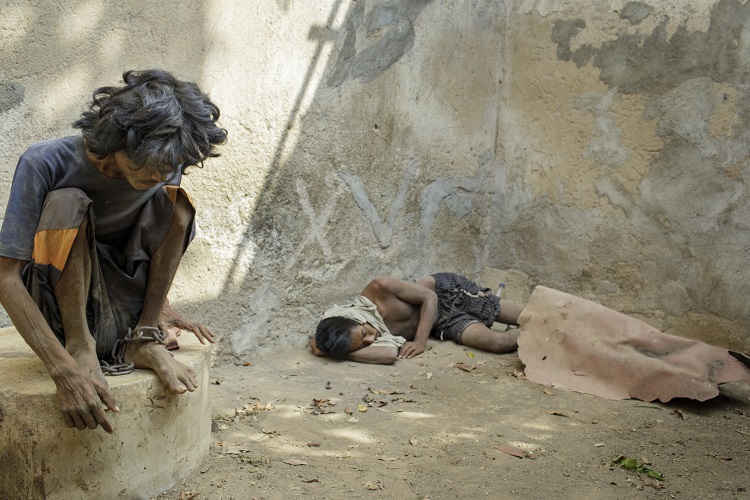
When I returned a month later, Muji’s condition had deteriorated. Being exposed to constant heat and dust in addition to being hungry, chained and surrounded by human waste is a formidable challenge. ‘Please hang on,’ I told, begged and urged him: ‘When it gets difficult, help the others around you’. I had nothing better to say.
Throughout Indonesia, thousands of people with severe mental illness are held indefinitely in deplorable conditions. Their situation is worse than those of prisoners who, at the very least, know the length of their sentence. Many of these people are hungry and are forced to eat, sleep and defecate while shackled or locked away in rooms, cells, cages or animal sheds while locked in wooden blocks (a practice called pasung). Caregivers resort to such practices out of desperation. Many can no longer care for their family members, do not have the time to seek medical care, distrust medications, fear addiction or are afraid of the shame and stigma attached to mental illness. Most caregivers are convinced that what they are doing is necessary to protect their family, the community and the individuals with mental illness themselves.
Efforts to raise standards
In 2016, the Ministry of Health instituted a neighbourhood door-to-door outreach initiative implemented by local community health centres. Members of a local outreach team had visited Siti. In many ways, this breakthrough program continues to achieve notable success. Unfortunately, providing adequate care to individuals with mental illness is often complicated.
In 2017 I interviewed former director of mental health at the Ministry of Health Dr Irmansyah, now associated with that ministry’s Agency of Health Research and Development (Litbangkes). He warned me: ‘There are no resources that can ensure patients continue to take their drugs’. He added: ‘Community psychiatric programs designed to prevent relapse are not implemented well everywhere. Therefore, it is not surprising that many people with mental illness do relapse. Eventually, their families return to their prior attitude that the care at psychiatric hospitals is an ineffective waste. After that, the people are placed back in pasung’.
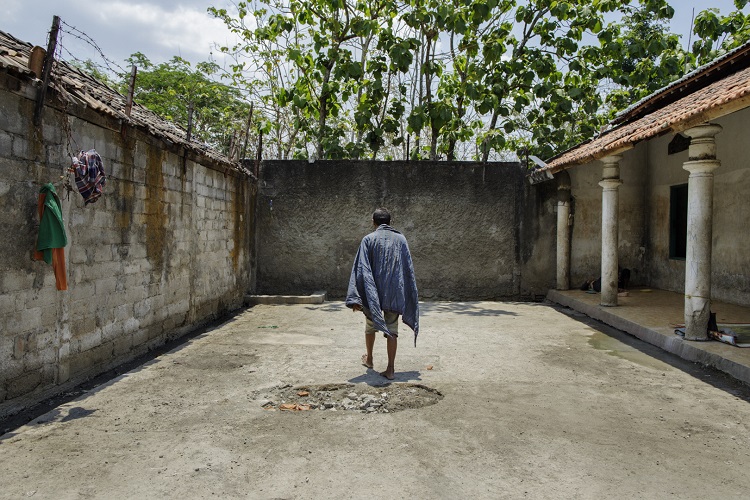
In the private panti that admit people with real or perceived psychosocial disabilities, little has changed since the passage of the Disability Act in 2016, which contains a mandate requiring the Indonesian government set minimal standards of care. ‘The purpose of this law is to clearly regulate services provided by the institutions that house people with psychosocial disabilities,’ said Dr Irmansyah. Head of Jakarta-based PJS (Indonesian Mental Health Association) Yeni Rosa Damayanti told me in January 2017: ‘It is not perfect, but it is a start. [Specific regulations] can create a strong legal base to stop all violence and the degrading treatments in panti’.
In many of Indonesia’s underserved communities, informal and unlicensed care facilities are staffed by untrained caregivers. These facilities are inadequate substitutes for the psychiatric care and treatment provided by hospitals and clinics. Such formal care is scarce, unevenly distributed across the country and often hard to access.
After local officials inspect these informal institutions, little happens. The owner of a facility in Central Java told me: ‘They come, they look around, they leave’. While some of the facilities I have documented benefit from independent grants or private donations, for the most part, the owners and staff of the majority of institutions that struggle financially inform me that there is ‘little government support,’ ‘no government support,’ ‘only some food,’ and ‘only some food, but nothing this year.’ Although some families pay fees for the care of family members, residents also include homeless individuals dropped off by local police who do not know where else to bring them. Residents are sometimes abandoned by their families after admission. Most informal facilities house their residents in cells, cages, or large, barred pens. The owners see this as an improvement over the use of chains. At one facility where chaining still occurs, I was told: ‘I agree with human rights.only used when the parents insist,’ and ‘If I don’t use chains, they will fight. I need high walls and many locked rooms’.
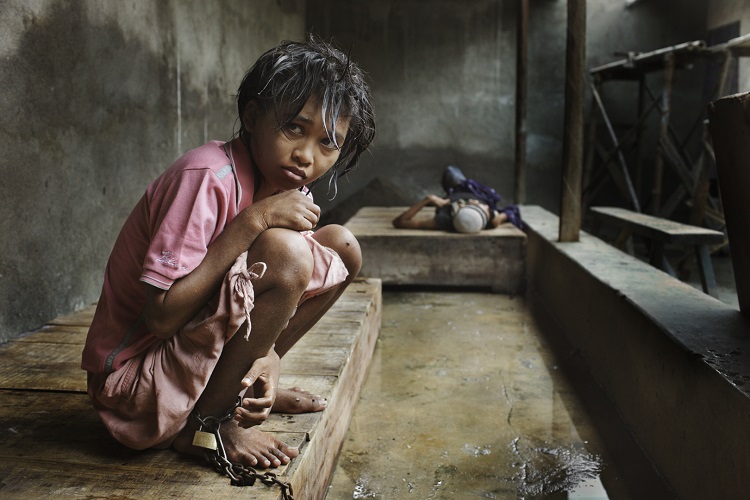
The role of photographers
While I photograph unaccompanied when possible, I do not work alone or without assistance. Any story concerning issues affecting persons with a real or perceived psychosocial disability in Indonesia requires research, consultations and interviews with Indonesian mental health professionals and disability rights activists engaged in the real work of advocating for change. My work also requires partnering with my Indonesian assistant, Gunawan, who also helps me source knowledgeable community members.
The most important part of my work is not my photography. Despite the persistent stigma that surrounds mental illness, people allow me to take pictures because they want people to know what is happening to them. They want people to see what they are subjected to on a daily basis. Their participation in my work as a photojournalist is ultimately part of their struggle for recognition, respect and freedom – their fight for the right to live.
Maybe the most critical part of my work is to ask, beg and urge countless adults and children to survive, value living and hold on to hope amidst the unspeakable conditions in which they are forced to live while they battle a severe mental illness that could be treated under better circumstances. I spend a few hours with them to accomplish this, armed with respect, focus, attention, bits of conversation and information. Weeks later, my assistants and I return, because we know that they are still there.
Ultimately, I can leave, while the people whom I photograph must stay. Even after nine years of working in Indonesia, leaving is still very hard. I will return. I work on a neurological battleground.
*My long-term coverage benefited from a lot of assistance from year to year from various activists, partners and experts, including: Dr Hervita Diatri (Cipto Mangunkusumo Hospital), Dr Yuniar Sunarko (Lawang Mental Hospital), Dr Irmansyah (Agency of Health Research and Development [Litbangkes]), Kriti Sharma (Human Rights Watch), Yeni Rosa Diamanti (Perhimpunan Jiwa Sehat, or Indonesian Mental Health Association), Bagus Utomo (Komunitas peduli Skizofrenia Indonesia, or the Indonesian Schitzophrenia Care Community), Nurhamid (Komunitas Sehat Jiwa, or Mental Health Community), Iin Purwanti Cox (consultant at Outpost), Gunawan (fixer), Bokir dan Anas dan semura narasumber local, juga almarhum Dr Pandu Setiawan (Jaringan Rehabilitasi Psikososial Indonesia, or the Indonesian Psychosocial Rehabilitation Network).
Andrea Star Reese (areese1230@gmail.com) is a photojournalist and documentary photographer based in New York. She produced DISORDER (2011-ongoing), a multi-year documentary reportage on abuse against people with psychosocial disabilities. Her photographs have appeared in many places, such as in her article for Time Magazine, 3 Sept 2013, and in the 2016 Human Rights Watch report entitled Living in Hell: Abuses against People with Psychosocial Disabilities in Indonesia. She currently works long-distance and pro bono with PJS on reports to government committees about the dangers of care facilities becoming Covid-19 hot spots. See more of her work on her website.

